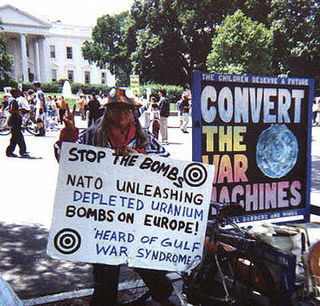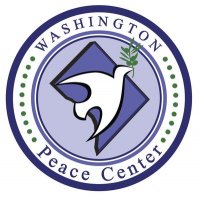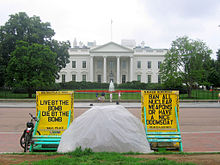
Nuclear disarmament is the act of reducing or eliminating nuclear weapons. Its end state can also be a nuclear-weapons-free world, in which nuclear weapons are completely eliminated. The term denuclearization is also used to describe the process leading to complete nuclear disarmament.

Pennsylvania Avenue is a primarily diagonal street in Washington, D.C. that connects the United States Capitol with the White House and then crosses northwest Washington, D.C. to Georgetown. Traveling through southeast Washington from the Capitol, it enters Prince George's County, Maryland, and becomes MD Route 4 and then MD Route 717 in Upper Marlboro, and finally Stephanie Roper Highway.
Norman David Mayer was an American anti-nuclear weapons activist who was shot and killed by the United States Park Police after threatening to blow up the Washington Monument.

Peace camps are a form of physical protest camp that is focused on anti-war and anti-nuclear activity. They are set up outside military bases by members of the peace movement who oppose either the existence of the military bases themselves, the armaments held there, or the politics of those who control the bases. They began in the 1920s and became prominent in 1982 due to the worldwide publicity generated by the Greenham Common Women's Peace Camp. They were particularly a phenomenon of the United Kingdom in the 1980s where they were associated with sentiment against American imperialism but Peace Camps have existed at other times and places since the 1920s.
New Jewish Agenda (NJA) was a multi-issue membership organization active in the United States between 1980 and 1992 and made up of about 50 local chapters. NJA's slogan was "a Jewish voice among progressives and a progressive voice among Jews." New Jewish Agenda demonstrated commitment to participatory (grassroots) democracy and civil rights for all people, especially those marginalized within the mainstream Jewish community. NJA was most controversial for its stances on the rights of Palestinians and Lesbian and Gay Jews.

Ellen Thomas is an American peace activist. She first became involved with the White House Peace Vigil on April 13, 1984. The daughter of a US Marine, Thomas was born in Brooklyn and grew up in California. She became opposed to nuclear weapons during her childhood. In protest at the policies of the United States government, she became a tax resister by simply living below the income tax threshold.

Concepción Picciotto, also known as Conchita or Connie, was a Spanish-born, United States–based peace activist. She lived in Lafayette Square, Washington, D.C., on the 1600 block of Pennsylvania Avenue, in a peace camp across from the White House, from 1 August 1981 in protest of nuclear arms until her death.

John Dear is an American Catholic priest, peace activist, lecturer, and author of 35 books on peace and nonviolence. He has spoken on peace around the world, organized hundreds of demonstrations against war, injustice and nuclear weapons and been arrested 85 times in acts of nonviolent civil disobedience against war, injustice, poverty, nuclear weapons and environmental destruction.

The Washington Peace Center was a nonprofit organization founded and located in Washington, D.C., focusing on peace and social justice. It officially closed ceased operating in 2020.

The anti-nuclear movement in the United States consists of more than 80 anti-nuclear groups that oppose nuclear power, nuclear weapons, and/or uranium mining. These have included the Abalone Alliance, Clamshell Alliance, Committee for Nuclear Responsibility, Nevada Desert Experience, Nuclear Information and Resource Service, Physicians for Social Responsibility, Plowshares Movement, United Steelworkers of America (USWA) District 31, Women Strike for Peace, Nukewatch, and Women's International League for Peace and Freedom. Some fringe aspects of the anti-nuclear movement have delayed construction or halted commitments to build some new nuclear plants, and have pressured the Nuclear Regulatory Commission to enforce and strengthen the safety regulations for nuclear power plants. Most groups in the movement focus on nuclear weapons.
Anti-nuclear organizations may oppose uranium mining, nuclear power, and/or nuclear weapons. Anti-nuclear groups have undertaken public protests and acts of civil disobedience which have included occupations of nuclear plant sites. Some of the most influential groups in the anti-nuclear movement have had members who were elite scientists, including several Nobel Laureates and many nuclear physicists.

A peace movement is a social movement which seeks to achieve ideals such as the ending of a particular war or minimizing inter-human violence in a particular place or situation. They are often linked to the goal of achieving world peace. Some of the methods used to achieve these goals include advocacy of pacifism, nonviolent resistance, diplomacy, boycotts, peace camps, ethical consumerism, supporting anti-war political candidates, supporting legislation to remove profits from government contracts to the military–industrial complex, banning guns, creating tools for open government and transparency, direct democracy, supporting whistleblowers who expose war crimes or conspiracies to create wars, demonstrations, and political lobbying. The political cooperative is an example of an organization which seeks to merge all peace-movement and green organizations; they may have diverse goals, but have the common ideal of peace and humane sustainability. A concern of some peace activists is the challenge of attaining peace when those against peace often use violence as their means of communication and empowerment.

Anti-nuclear protests began on a small scale in the U.S. as early as 1946 in response to Operation Crossroads. Large scale anti-nuclear protests first emerged in the mid-1950s in Japan in the wake of the March 1954 Lucky Dragon Incident. August 1955 saw the first meeting of the World Conference against Atomic and Hydrogen Bombs, which had around 3,000 participants from Japan and other nations. Protests began in Britain in the late 1950s and early 1960s. In the United Kingdom, the first Aldermaston March, organised by the Campaign for Nuclear Disarmament, took place in 1958. In 1961, at the height of the Cold War, about 50,000 women brought together by Women Strike for Peace marched in 60 cities in the United States to demonstrate against nuclear weapons. In 1964, Peace Marches in several Australian capital cities featured "Ban the Bomb" placards.

Lafayette Square is a seven-acre public park located within President's Park in Washington, D.C., directly north of the White House on H Street, bounded by Jackson Place on the west, Madison Place on the east and Pennsylvania Avenue on the south. It is named for the general, the Marquis de Lafayette, a French aristocrat, and hero of the American Revolutionary War (1775–1783) and includes several statues of revolutionary heroes from Europe, including Lafayette, while at its center is a famous statue of early 19th century U.S. president and general Andrew Jackson on horseback with both of the horse's front hooves raised.

William Thomas Hallenback Jr., known as Thomas, was an American anti-nuclear activist and simple-living adherent who undertook a 27-year peace vigil – the longest recorded vigil in US history at the time, with the title passing to his co-protester Concepción Picciotto after Thomas' death – in front of the White House.

The Parliament Square Peace Campaign was a peace camp outside the Palace of Westminster in Parliament Square, London, from 2001 to 2013. Activist Brian Haw launched the campaign at the site on 2 June 2001, initially as an around-the-clock protest in response to the United Nations economic sanctions imposed on Iraq. His protest grew broader following the war in Afghanistan and 2003 invasion of Iraq. He was joined by Barbara Tucker in December 2005, and stayed at the site day and night for nearly a decade.

Pacifism has manifested in the United States in a variety of forms, and in myriad contexts. In general, it exists in contrast to an acceptance of the necessity of war for national defense.
Sister Anne Montgomery, RSCJ was an American non-violent activist and educator of young children who was part of the Plowshares movements and campaigned against the US government for peace. Aside from teaching, she worked with the poor, advocated for peace and the Catholic Worker Movement. Anne Montgomery House in Washington, D.C., run by the Society of the Sacred Heart, is named for her.

The Black Lives Matter Memorial Fence was a two-block eight-month long protest art installation of Black Lives Matter memorials attached by visitors and community activists to the chain link fence outside the White House on H Street, between Vermont Avenue and Connecticut Avenue NW in Downtown Washington, D.C. in 2020 and 2021. The 1.7-mile (2.7 km) cordon of fencing around the White House was erected to move the growing crowds of protesters gathered at and around Lafayette Park after the murder of George Floyd on May 25, 2020. The Memorial Fence developed from June 2020 until it was dismantled and archived in January 2021. Members of the public worked together to maintain, protect, and then archive the thousands of signs and artworks that were offered by the public.
















